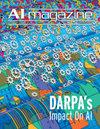高尺度多域视角下盲图像超分辨率深度学习技术评价
IF 2.5
4区 计算机科学
Q3 COMPUTER SCIENCE, ARTIFICIAL INTELLIGENCE
引用次数: 0
摘要
尽管在深度学习(DL)的推动下,最近已经进行了一些解决方案和实验来解决图像超分辨率(SR)问题,但它们通常不会设计具有高缩放因子的评估。此外,数据集通常是基准,并没有真正包含重要的领域多样性,以正确评估技术。同样有趣的是,盲SR对于现实世界的场景是有吸引力的,因为它是基于退化过程未知的想法,因此,在这种情况下,技术基本上依赖于低分辨率(LR)图像。在这篇文章中,我们提出了一个高尺度(8倍)实验,评估了最近为盲图像SR定制的五种深度学习技术:自适应伪增强(APA)、具有空间变异退化的盲图像SR (BlindSR)、深度交替网络(DAN)、FastGAN和混合专家超分辨率(MoESR)。我们考虑了来自五个不同更广泛领域(航空、动物、植物、医疗和卫星)的14个数据集,另一个评论是,一些深度学习方法是为单图像SR设计的,而另一些则不是。基于NIQE和基于变压器的MANIQA评分这两个无参考指标,MoESR可以被认为是最佳解决方案,尽管所有技术创建的高分辨率(HR)图像的感知质量仍有待提高。本文章由计算机程序翻译,如有差异,请以英文原文为准。
Evaluating Deep Learning Techniques for Blind Image Super-Resolution within a High-Scale Multi-Domain Perspective
Despite several solutions and experiments have been conducted recently addressing image super-resolution (SR), boosted by deep learning (DL), they do not usually design evaluations with high scaling factors. Moreover, the datasets are generally benchmarks which do not truly encompass significant diversity of domains to proper evaluate the techniques. It is also interesting to remark that blind SR is attractive for real-world scenarios since it is based on the idea that the degradation process is unknown, and, hence, techniques in this context rely basically on low-resolution (LR) images. In this article, we present a high-scale (8×) experiment which evaluates five recent DL techniques tailored for blind image SR: Adaptive Pseudo Augmentation (APA), Blind Image SR with Spatially Variant Degradations (BlindSR), Deep Alternating Network (DAN), FastGAN, and Mixture of Experts Super-Resolution (MoESR). We consider 14 datasets from five different broader domains (Aerial, Fauna, Flora, Medical, and Satellite), and another remark is that some of the DL approaches were designed for single-image SR but others not. Based on two no-reference metrics, NIQE and the transformer-based MANIQA score, MoESR can be regarded as the best solution although the perceptual quality of the created high-resolution (HR) images of all the techniques still needs to improve.
求助全文
通过发布文献求助,成功后即可免费获取论文全文。
去求助
来源期刊

Ai Magazine
工程技术-计算机:人工智能
CiteScore
3.90
自引率
11.10%
发文量
61
审稿时长
>12 weeks
期刊介绍:
AI Magazine publishes original articles that are reasonably self-contained and aimed at a broad spectrum of the AI community. Technical content should be kept to a minimum. In general, the magazine does not publish articles that have been published elsewhere in whole or in part. The magazine welcomes the contribution of articles on the theory and practice of AI as well as general survey articles, tutorial articles on timely topics, conference or symposia or workshop reports, and timely columns on topics of interest to AI scientists.
 求助内容:
求助内容: 应助结果提醒方式:
应助结果提醒方式:


